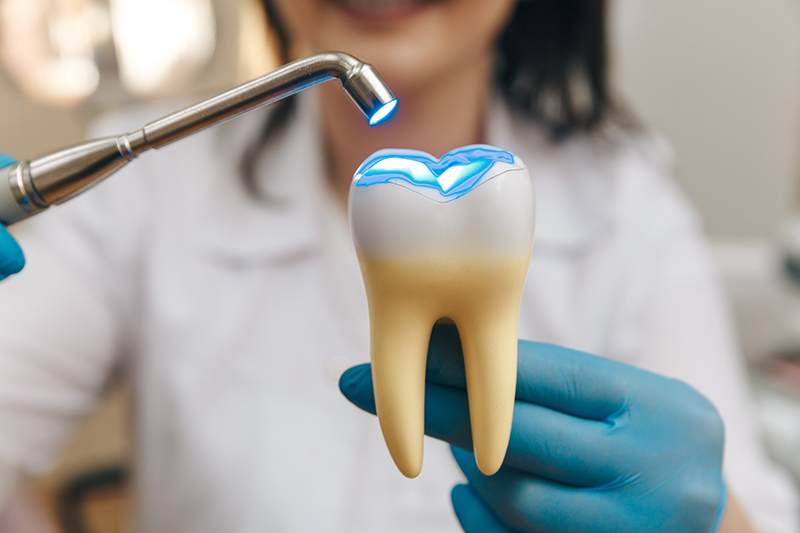Dental Fillings Durham, NC
Dental fillings are used to repair damage to the enamel. Even though enamel is the hardest substance in the human body, it isn’t invulnerable. Poor hygiene, acidic foods, and trauma can deteriorate the enamel, causing tooth cavities and fractures.
Your Durham dentists may recommend fillings as a restorative treatment for the following reasons:
- Tooth decay: Oral bacteria produce acids that deteriorate the enamel causing cavities. Fillings can be used to seal tooth cavities and halt further deterioration.
- Worn teeth: The teeth experience wear and tear due to chewing, enamel erosion, and compulsive grinding. Fillings can help restore tooth integrity and slow down further wear and tear.
- Tooth sensitivity: Sensitivity to hot and cold temperatures often points to exposed dentin or exposed roots of the tooth. Fillings can cover the exposed tooth structure and reduce tooth sensitivity.
- Tooth fractures: Fractures and cracks can develop on the tooth due to trauma or accidents. Fillings can help strengthen the tooth and prevent fractures from developing further.

Types of Fillings
There are several types of dental fillings, each made from unique artificial materials. Your dentist will consider the unique properties of each kind of filling and your preferences when making a recommendation.
The main types of fillings include:
- Silver amalgam fillings: These are made of silver and a combination of different metals such as mercury, tin, and copper. Silver amalgam fillings can withstand immense chewing forces, making them ideal for molars and premolars.
- Composite fillings: Composite fillings are made from a plastic blend indistinguishable from the enamel. Their durability and natural look make them a popular choice for visible teeth.
- Gold fillings: These fillings are a blend of gold, copper, and other metals. Gold fillings have aesthetic appeal but are more expensive and less durable than silver amalgam fillings.
- Ceramic fillings: While ceramic fillings aren’t as strong as silver amalgam fillings, they are tooth-colored, making them perfect for visible teeth. Moreover, ceramic fillings’ structural integrity and strength improve when fused to the affected tooth.
- Glass ionomer fillings: Made from a blend of glass and acrylic, glass ionomer fillings are reserved for teeth that experience minimal chewing forces. While glass ionomer fillings aren’t as durable as gold or silver amalgams, they protect the tooth structure beneath the gum line from decay by releasing fluoride.
What Can You Expect During a Dental Filling Procedure?
Preparation
The dentist may take dental x-rays of the affected tooth to determine the extent of damage and decide whether fillings will be an effective treatment.
Next, the dentist recommends the best type of filling material depending on the tooth’s function, location, extent of damage, and personal preference.
Once you have decided on a filling material, the dentist will administer local anesthesia to numb the gums surrounding the affected tooth and prevent or minimize discomfort during the procedure.
Removal of Decay
The dentist ensures you’re comfortable before proceeding with the decay removal process. They will carefully remove the damaged and decayed parts of the tooth using specialized dental tools
The dentist may use a dental mirror to examine the affected tooth if it’s in hard-to-reach areas of the mouth. They then remove decayed tissue and debris using a spoon excavator or a dental extractor.
Sometimes, the dentist may use a dental drill to dislodge decayed tissue. They occasionally spray water onto the damaged tooth to cool it while drilling. This helps prevent the tooth from overheating and damaging the surrounding gum tissue.
Filling the Cavity
Before filling the cavity, the dentist probes the tooth to ensure it’s free of dead tissue and debris. They may use an acid etching solution to create tiny grooves in the affected tooth so that the filling material fuses securely.
Next, the dentist carefully applies the filling material to the cavity. They apply the filling in layers, shaping each layer before hardening it using a blue curing light. This multilayering process is crucial since each filling layer must fit snugly into the cavity.
After the layering, the dentist shapes and polishes the filling material to prevent it from interfering with your bite and the surrounding teeth. They may use a high-speed dental bur to achieve the desired result, removing excess filling material and ensuring it blends naturally with the surrounding teeth.
Dental Filling Aftercare
Fillings are durable and resilient. However, you must take proper care of the filling after its application to ensure it remains intact. Your dentist may recommend the following dental filling aftercare instructions:

- Take medication as prescribed: Take the anti-inflammatory medication prescribed by your dentist to alleviate soreness and discomfort after the filling procedure.
- Maintain good oral hygiene: Don’t hesitate to clean your teeth after a filling procedure. However, be gentle when brushing and flossing the affected tooth. Also, you may use mouthwash to clean hard-to-reach areas of the mouth and the treated tooth.
- Watch your diet: It would be best if you avoid eating or drinking immediately after the filling procedure. You can resume eating once the anesthesia wears off, but avoid hard or sticky foods such as nuts and candies, as they can damage or dislodge the filling.
- Attend regular checkups: Make a point of attending your dental checkups. Your dentist will examine the treated tooth and address any complications with the filling.
- Keep in touch with your dentist: Be sure to contact your dentist if you notice swelling, gum tenderness, and tooth sensitivity that doesn’t improve after a few days.
With the proper care, dental fillings can last for many years, depending on the filling type and location. For instance, silver amalgam fillings can last anywhere from 12 to 20 years. On the other hand, composite fillings are less resilient and may need regular replacements if the tooth experiences immense chewing force. Composite fillings have advanced over the years and some have clinical longevity that is comparable to amalgam restorations.
Dental Filling Complications
Fillings are a safe and non-invasive dental treatment. However, complications can occur during and after the procedure.
Risks of complications include:
- Allergic reactions: Though rare, you might be allergic to certain filling materials. You should contact your dentist immediately if you notice swelling of the gums, hives, or difficulty breathing.
- Anesthetic complications: There is a slight risk of nerve damage and blood vessel injury during the anesthetic injection. However, this is an uncommon complication.
- Infection: An infection may develop in the surrounding tissues, especially if the filling isn’t correctly placed. Oral bacteria may infiltrate the tooth and infect the pulp leading to complications.
- Persistent pain and discomfort: While slight pain and discomfort are common, you should consult your dentist if you’re experiencing constant pain days after the procedure.
- Tooth damage: In rare cases, the filling may expand and contract, damaging the tooth over time. Moreover, there’s a slight risk that the surrounding teeth may be damaged during the filling procedure.
It’s important to note that complications rarely occur. Additionally, following the aftercare instructions your dentist recommends drastically reduces the risk of developing complications after the procedure.

Alternatives to Dental Fillings
While fillings are an effective treatment for tooth cavities, your dentist may recommend alternatives depending on your preference, damage extent, and the tooth’s location.
Alternatives to dental fillings include:
Dental Crowns
Dental crowns are durable and custom restorations covering the tooth’s portion above the gum line. Dental crowns are used in cases of severe decay or tooth damage to restore the tooth’s function and strength.
Inlays and Onlays
Inlays and Onlays treat moderate tooth decay and damage on the tooth’s chewing surface. Like dental crowns, they are custom-made to bond to a specific tooth.
Dental Bonding
Dental bonding is a restorative procedure used to treat minor tooth damage. The dentist applies a tooth-colored resin material to the affected tooth restoring its function, strength, and aesthetic appeal.
Root Canal Therapy
Root canal therapy is a dental procedure for extensive tooth damage and decay. It involves removing infected pulp tissue from the damaged tooth and replacing it with a biocompatible material.
Tooth Extraction
Tooth extraction is a last resort in severe tooth damage and decay cases. Your dentist will recommend tooth extraction to avoid complications when other restorative treatments are ineffective.
Dental fillings are a safe restorative treatment for tooth damage and cavities. Fillings restore tooth functionality and prevent the need for intrusive treatment alternatives such as root canals and tooth extraction. Give us a call today to schedule a consultation with one of our skilled dentists about fillings and other restorative dental procedures.
Schedule Today!
We look forward to meeting you. Call (919) 646-3849 or request an appointment online to set up your first visit. We’ll be in touch soon.
O2 Dental Group of Durham
(919) 646-3849
Monday:
Tuesday:
Wednesday:
Thursday:
Friday:
Saturday:
Sunday:
9:00am – 5:00pm
9:00am – 5:00pm
9:00am – 5:00pm
9:00am – 5:00pm
8:00am – 2:00pm (every other Friday)
CLOSED
CLOSED

